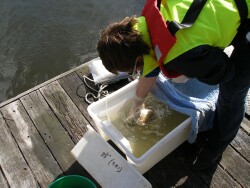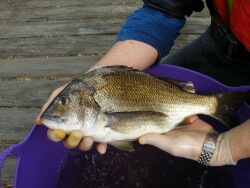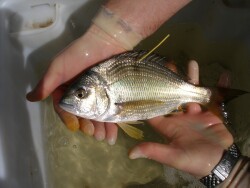Tracking the movement of black bream in the Yarra and Maribyrnong estuaries
| Tracking the movement of black bream in the Yarra and Maribyrnong estuaries Regional estuaries have received most attention in describing habitat preferences, ecology and biology of fish. The Yarra/Maribyrnong estuaries are among the largest systems in central Victoria and are highly urbanised. Both systems also support rich assemblages of fish. Unfortunately, however, we know virtually nothing of how, when or why habitat preferences and patterns of movement change. Understanding the movement of fish in relation to changes in the environment is a critical first step in managing estuarine ecosystems to support fish, and ultimately forms the basis for future research programs on biodiversity-habitat linkages, spawning and recruitment. An exciting new partnership between Arthur Rylah Institute (DSE) (external link), Marine and Freshwater Systems (DPI), Melbourne Water (external link) and the University of Melbourne (external link) has provided an opportunity to study the movement patterns of a key estuarine fish species (black bream, Acanthopagrus butcheri). |  Recovery of Black Bream after tagging |
 Black bream caught in the Yarra River estuary |
In late September we implanted acoustic transmitters (pingers) into 20 black bream caught in the Yarra River. Day-to-day patterns of movement by these fish will be monitored over the next 12 months. Stay tuned for results. This project will help to increase understanding of the spatial ecology and behaviour of fish in the Yarra/Maribyrnong estuaries. Specifically, the project will provide information on: |

Tagged bream before release into the Yarra River estuary


